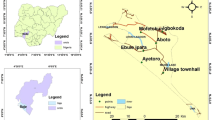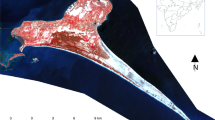Abstract
Shorelines are one of the most important land surface phenomena with a dynamic nature. Coastal monitoring is an important parameter in sustainable development and environmental protection. Coastal monitoring requires the extraction of shorelines at different times. Nowadays, remote sensing data are considered the most efficient source of information for the study and interpretation of coastal landforms, tidal levels and changes of shoreline and water depth. The main objectives of studying the shoreline from Charak port to Aftab port are to provide a map to calculate shoreline changes, determine erosion and accretion areas and the extent of shoreline advance and retreat to better coastal management. Furthermore, design and construction of suitable coastal facilities, determining the safe margin and ultimately realizing the 14th principle of sustainable development, are other objectives. The case study in this paper is to extract the shoreline of Charak port to Aftab port in the Persian Gulf using five Landsat satellite imageries from 1998 to 2017. For this purpose, in the first stage by applying radiometric, atmospheric and noise reduction corrections and in the second stage by taking training samples of each imagery and also supervised classification methods (SVM and maximum likelihood methods), the boundary between "water" and "land" was specified in each image. Then, the accuracy of each classification method was evaluated using two parameters of overall accuracy and kappa coefficient. The results of image classification methods show that the SVM and maximum likelihood methods have a high accuracy in separating the boundary between water and land. Nevertheless, the SVM method has a higher accuracy than the maximum likelihood method. In these two methods, the minimum and maximum differences in overall accuracy are 0.06 and 0.6%, respectively. Furthermore, the minimum and maximum differences in kappa coefficient are 0.0016 and 0.0117, respectively. Finally, these imageries were transferred to ArcGIS software and shorelines were extracted and beach maps were prepared at a scale of 1: 50,000.








Similar content being viewed by others
References
Bagli, S., & Soille, P. (2003, October). Morphological automatic extraction of Pan-European coastline from Landsat ETM+ images. In International symposium on GIS and computer cartography for coastal zone management (pp. 256–269).
Bamdadinejad, M., Ketabdari, M. J., & Rezaei, S. (2020a). Pneumatic Breakwaters and Their Use for Ships Protection in Coastal and Offshore Areas of the Persian Gulf. Science and Engineering, 64(3), 94–99.
Bamdadinejad, M., Ketabdari, M. J., & Shojaei, F. (2020b). Numerical Modeling of Sediment Transport Rate and Shoreline Changes of Jazireh-e Shomali-Jonoubi Port in the Persian Gulf. Science and Engineering, 64(2), 39–45.
Bayram, B., Acar, U., Seker, D., & Ari, A. (2008). A novel algorithm for coastline fitting through a case study over the Bosphorus. Journal of Coastal Research, 24(4 (244)), 983–991. https://doi.org/10.2112/07-0825.1
Bo, G., Delleplane, S., & De Laurentiis, R. (2001). Coastline extraction in remotely sensed images by means of texture features analysis. In IGARSS 2001. Scanning the Present and Resolving the Future. Proceedings. IEEE 2001 International Geoscience and Remote Sensing Symposium (Cat. No. 01CH37217) (Vol. 3, pp. 1493–1495). IEEE. https://doi.org/10.1109/IGARSS.2001.976889
Boak, E. H., & Turner, I. L. (2005). Shoreline definition and detection: a review. Journal of coastal research, 21(4 (214)), 688–703. https://doi.org/10.2112/03-0071.1
Böhme, B., Steinbruch, F., Gloaguen, R., Heilmeier, H., & Merkel, B. (2006). Geomorphology, hydrology, and ecology of Lake Urema, central Mozambique, with focus on lake extent changes. Physics and Chemistry of the Earth, Parts a/b/c, 31(15–16), 745–752. https://doi.org/10.1016/j.pce.2006.08.010
Braga, F., Tosi, L., Prati, C., & Alberotanza, L. (2013). Shoreline detection: Capability of COSMO-SkyMed and high-resolution multispectral images. European Journal of Remote Sensing, 46(1), 837–853. https://doi.org/10.5721/EuJRS20134650
Chu, Z. X., Sun, X. G., Zhai, S. K., & Xu, K. H. (2006). Changing pattern of accretion/erosion of the modern Yellow River (Huanghe) subaerial delta, China: Based on remote sensing images. Marine Geology, 227(1–2), 13–30. https://doi.org/10.1016/j.margeo.2005.11.013
Di, K., Wang, J., Ma, R., & Li, R. (2003). Automatic shoreline extraction from high-resolution IKONOS satellite imagery. In Proceeding of ASPRS 2003 Annual Conference (Vol. 3).
Ekercin, S. (2007). Coastline change assessment at the Aegean Sea coasts in Turkey using multitemporal Landsat imagery. Journal of Coastal Research, 23(3 (233)), 691–698. https://doi.org/10.2112/04-0398.1
Gens, R. (2010). Remote sensing of coastlines: Detection, extraction and monitoring. International Journal of Remote Sensing, 31(7), 1819–1836. https://doi.org/10.1080/01431160902926673
Giannini, M. B., & Parente, C. (2015). An object based approach for coastline extraction from Quickbird multispectral images. Int. J. Eng. Technol, 6(6), 2698–2704.
Guariglia, A., Buonamassa, A., Losurdo, A., Saladino, R., Trivigno, M. L., Zaccagnino, A., & Colangelo, A. (2006). A multisource approach for coastline mapping and identification of shoreline changes. Annals of geophysics, 49(1).
Hoeke, R. K., Zarillo, G. A., & Synder, M. (2001). A GIS-Based Tool for Extracting Shoreline Postions from Aerial Imagery (BeachTools) (No. ERDC/CHL-CHETN-IV-37). Engineer Research and Development Center Vicksburg MS Coastal and Hydraulics Lab.
Hoonhout, B. M., Radermacher, M., Baart, F., & Van der Maaten, L. J. P. (2015). An automated method for semantic classification of regions in coastal images. Coastal Engineering, 105, 1–12. https://doi.org/10.1016/j.coastaleng.2015.07.010
Huang, X., Guan, X., Benediktsson, J. A., Zhang, L., Li, J., Plaza, A., & Dalla Mura, M. (2014). Multiple morphological profiles from multicomponent-base images for hyperspectral image classification. IEEE Journal of Selected Topics in Applied Earth Observations and Remote Sensing, 7(12), 4653–4669. https://doi.org/10.1109/JSTARS.2014.2342281
Jishuang, Q., Chao, W., & Zhengzhi, W. (2002). A multi-threshold based morphological approach for extracting coastal line feature in remote sensed images. International Archives of Photogrammetry Remote Sensing and Spatial Information Sciences, 34(1), 184–188.
Kuleli, T., Guneroglu, A., Karsli, F., & Dihkan, M. (2011). Automatic detection of shoreline change on coastal Ramsar wetlands of Turkey. Ocean Engineering, 38(10), 1141–1149. https://doi.org/10.1016/j.oceaneng.2011.05.006
La Monica G, B., Petrocchi, E., Salvatore, M. C., Salvatori, R., & Casacchia, R. (2008). A new approach to detect shoreline from satellite images. http://hdl.handle.net/11568/120612
Li, R., Di, K., & Ma, R. (2001). A comparative study of shoreline mapping techniques. GIS for coastal zone management, 53–60.
Liu, H., & Jezek, K. C. (2004a). A complete high-resolution coastline of Antarctica extracted from orthorectified Radarsat SAR imagery. Photogrammetric Engineering & Remote Sensing, 70(5), 605–616. https://doi.org/10.14358/PERS.70.5.605
Liu, H., & Jezek, K. C. (2004b). Automated extraction of coastline from satellite imagery by integrating Canny edge detection and locally adaptive thresholding methods. International Journal of Remote Sensing, 25(5), 937–958. https://doi.org/10.1080/0143116031000139890
Maiti, S., & Bhattacharya, A. K. (2009). Shoreline change analysis and its application to prediction: A remote sensing and statistics based approach. Marine Geology, 257(1–4), 11–23. https://doi.org/10.1016/j.margeo.2008.10.006
Mountrakis, G., Im, J., & Ogole, C. (2011). Support vector machines in remote sensing: A review. ISPRS Journal of Photogrammetry and Remote Sensing, 66(3), 247–259. https://doi.org/10.1016/j.isprsjprs.2010.11.001
Muslim, A. M., Ismail, K. I., Khalil, I., Razman, N., & Zain, K. (2011, April). Detection of shoreline changes at Kuala Terengganu, Malaysia from multi-temporal satellite sensor imagery. In Proceedings of the 34th International Symposium on Remote Sensing of Environment, Sydney, Australia (pp. 10–15).
Nguyen, H. H., McAlpine, C., Pullar, D., Johansen, K., & Duke, N. C. (2013). The relationship of spatial–temporal changes in fringe mangrove extent and adjacent land-use: Case study of Kien Giang coast, Vietnam. Ocean & Coastal Management, 76, 12–22. https://doi.org/10.1016/j.ocecoaman.2013.01.003
Ozturk, D., & Sesli, F. A. (2015). Shoreline change analysis of the Kizilirmak Lagoon Series. Ocean & Coastal Management, 118, 290–308. https://doi.org/10.1016/j.ocecoaman.2015.03.009
Pardo-Pascual, J. E., Almonacid-Caballer, J., Ruiz, L. A., & Palomar-Vázquez, J. (2012). Automatic extraction of shorelines from Landsat TM and ETM+ multi-temporal images with subpixel precision. Remote Sensing of Environment, 123, 1–11. https://doi.org/10.1016/j.rse.2012.02.024
Rasuly, A., Naghdifar, R., & Rasoli, M. (2010). Monitoring of Caspian Sea coastline changes using object-oriented techniques. Procedia Environmental Sciences, 2, 416–426. https://doi.org/10.1016/j.proenv.2010.10.046
Rishikeshan, C. A., & Ramesh, H. (2017). A novel mathematical morphology based algorithm for shoreline extraction from satellite images. Geo-Spatial Information Science, 20(4), 345–352. https://doi.org/10.1080/10095020.2017.1403089
Scott, D. B. (2005). Coastal changes, rapid. Encyclopedia of coastal sciences. Springer, The Netherlands, 253–255.
Wang, C., Zhang, J., & Ma, Y. (2010). Coastline interpretation from multispectral remote sensing images using an association rule algorithm. International Journal of Remote Sensing, 31(24), 6409–6423. https://doi.org/10.1080/01431160903413739
White, K., & El Asmar, H. M. (1999). Monitoring changing position of coastlines using Thematic Mapper imagery, an example from the Nile Delta. Geomorphology, 29(1–2), 93–105. https://doi.org/10.1016/S0169-555X(99)00008-2
Author information
Authors and Affiliations
Corresponding author
Additional information
Publisher's Note
Springer Nature remains neutral with regard to jurisdictional claims in published maps and institutional affiliations.
About this article
Cite this article
Bamdadinejad, M., Ketabdari, M.J. & Chavooshi, S.M.H. Shoreline Extraction Using Image Processing of Satellite Imageries. J Indian Soc Remote Sens 49, 2365–2375 (2021). https://doi.org/10.1007/s12524-021-01398-3
Received:
Accepted:
Published:
Issue Date:
DOI: https://doi.org/10.1007/s12524-021-01398-3




